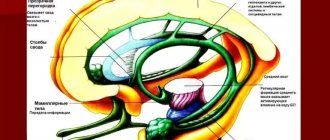tags:
Emotional, Emotion, Person, Feeling, Situation, Joy, Decrease, Formation 1. Regulatory function - a word can heal;
2. Signaling function - emerging experiences signal to a person what obstacles he encounters on his way;
3. Stimulating function;
4. Evaluative function of emotions. Emotion allows you to instantly analyze the meaning of a situation or an isolated stimulus for a person. Evaluation at the level of emotions anticipates the conscious processing of information and “addresses” it in a certain direction.
5. Communicative - facial expressions allow a person to convey his experiences to other people, inform them about his attitude towards objects.
Classification of emotions and feelings. Classification of emotions.
In many emotional manifestations, four initial emotions are distinguished: joy (pleasure), fear, anger, surprise.
Most emotions are mixed. According to Izard: joy, positive emotional state; astonishment; guilt; anger, a negative emotional state that occurs in the form of affect; disgust caused by objects (objects, people...); contempt; fear; shame; interest; grief. According to Schneider:
1. Emotional states: pleasant (joy, surprise); unpleasant (sadness, fear);
2. Self-directed emotions: pleasant (pride, stubbornness); unpleasant (embarrassment, guilt);
3. Emotions directed at others: pleasant (love); unpleasant (hatred, disgust).
Properties of emotions
Emotions, as a special class of mental phenomena, have a number of distinctive features and patterns of their functioning.
Partiality (subjectivity) -
the dependence of a person’s response to various events in his life on his subjective attitude towards them (determined by his needs, attitudes, experience, temperament, etc.). Any mental phenomenon is subjective. When we talk about the subjective nature of the functioning of emotions, their ability to determine and identify the subjective, personal significance of an event for a particular person is emphasized. P. V. Simonov calls emotions “a universal measure of significance.” This significance is composed of the current state of the individual’s motivational sphere, his past experience, in particular the success/slowness of carrying out certain types of activities, as well as stable (innate or acquired) features of emotional response. For example, speaking in front of an audience is a source of positive emotions for some people, while for others it is associated with significant feelings of anxiety and embarrassment, and these negative experiences can be caused by both the person’s innate shyness and previous failures in public speaking.
Integrity —
combining all the functions of the body into a single whole. This is a property of emotions, according to P.K. Anokhin, allows, even before the form, type, mechanism and other parameters of certain influences are determined, to instantly assess their usefulness or harm to the body and quickly respond with the help of a certain quality of emotional state, thereby contributing to the successful adaptation of the individual.
Plastic —
a variety of shades of experiencing an emotion of one modality, both quantitative (intensity, duration, etc.) and qualitative (sign). For example, experiencing the emotion of fear (which is generally called a negative emotion) among thrill-seekers can cause a joyful, upbeat mood.
Adaptation is a dulling, reduction in the intensity of emotional reactions (up to their complete disappearance) with long repetition of the same influences. Thus, prolonged exposure to a pleasant stimulus causes a weakening of the experience of pleasure. For example, frequently rewarding employees in the same way leads to the fact that they stop reacting emotionally to these rewards. At the same time, a break in the action of the stimulus or a change in it can again cause pleasure. According to V. Vitvitsky, moderate intensity displeasure also undergoes adaptation, but adaptation to pain does not occur.
Summation —
combining individual emotions into more complex emotional formations. In this case, both a “spatial” unification of emotional reactions experienced simultaneously and a temporal summation of experiences following each other are possible. Emotions associated with the same object are summed up throughout life, which leads to an increase in their intensity, strengthening of feelings, as a result of which their experience can become stronger. V. Vitvitsky notes that a person usually experiences the strongest pleasure or displeasure not at the first, but at subsequent presentations of an emotiogenic stimulus. Often the process of summation of emotional experiences is hidden and is not realized by the person (the “last straw” effect).
For some theories (W. McDougall, R. Plutchik, W. Wundt, etc.), the possibility of connecting emotions is the basic principle that explains the emergence of complex emotions from simpler ones. V. Wundt examines in detail the basic principles of combining emotional elements into a “single resultant feeling”: the principle of gradation of elements, the principle of the value of the whole, the principle of enhancing the value of feelings when they are added.
Ambivalence (from Latin ambo -
both and
valentis -
having strength) - the inconsistency of emotional experience associated with an ambivalent attitude towards something or someone and characterized by its simultaneous acceptance and rejection. In other words, a person simultaneously experiences both positive and negative emotional experiences. The term was proposed by the Swiss psychologist and psychiatrist E. Bleier. In the psychoanalytic direction, this phenomenon is traditionally explained by the presence of conflicts in the motivational sphere of a person. The variety of needs, the versatility of the phenomena of the surrounding reality in a poorly integrated personality can contribute to the emergence of such a dual attitude. However, according to A.N. Leontiev, ambivalence is not an inherent feature of emotions, but arises as a result of the discrepancy or inconsistency of such subclasses of emotional processes as feelings and emotions themselves, i.e. stable emotional relationships to the object and emotional reactions to the current transient situation (a loved one can in a certain situation cause a transient emotion of displeasure, anger).
Dynamism is the temporary development of emotional reactions, which consists in the phase nature of their course.
For example, the Polish psychologist T. Tomaszewski was able to identify four phases in the development of the emotion of anger:
1) cumulation (accumulation of excitation);
2) turning point - explosion;
3) voltage reduction;
4) extinction.
Communication skills —
transmission through emotional expression (intonation, voice timbre, facial expressions, gestures, etc.) of information from one participant in communication to another. As K. Izard notes, a child, long before he can understand speech addressed to him and pronounce individual words, is able to communicate to others about his internal state using means of emotional expression.
Contagiousness is the transfer of any emotional state to other people. As a result, both general joy and boredom or panic can arise, therefore this property of emotions is most closely studied by social psychologists (for example, when studying the mechanisms of formation of group cohesion or human behavior in a crowd). According to P. Fress, the contagiousness of emotions increases when the social distance between individuals decreases, as well as when external emotional manifestations are clearly expressed. Strengthens the contagiousness of emotions and identification with the person experiencing this or that experience.
Anticipation _
— forecasting the probabilistic outcome of significant events before they occur. Such forecasting becomes possible due to the actualization of ideas about experienced or imagined situations. Apparently, it is this property that underlies the functioning of such an emotional experience as anxiety.
Mnesticism is the remembering, preservation and reproduction of emotions when repeatedly exposed to or imagining the situation in which they arose. In this regard, a special type of memory is distinguished - emotional memory. PM Granovskaya names the following features of the functioning of this type of memory: the speed of formation of traces, their special strength and involuntary reproduction. To this day, the question of which emotional experiences are better remembered remains debatable. At the beginning of the 20th century. Among Western psychologists, the prevailing view was that positive emotions are better preserved in memory. According to Z. Freud, this is due to the action of the repression mechanism, which seeks to remove all unpleasant and traumatic experiences into the unconscious sphere. P.P. Blonsky, on the contrary, argued that negative emotions are remembered better because it is more biologically expedient: an animal that forgets what causes it suffering is doomed to quick death. According to P.V. Simonov, the emotional coloring of memories depends not on the strength of the emotions experienced at the moment of the event itself, but on the relevance of these memories for the subject at the moment.
Along with imprinting a particular emotional experience, emotional memory provides quick and lasting memorization of the reason that caused it, but often such information is not very accurate, and sometimes even greatly distorted.
Irradiation is the spread of emotional experience from the circumstances that originally caused it to everything that is perceived by a person. Thus, to a happy person “everything is smiling”, it seems pleasant and joyful; an angry person, on the contrary, is irritated by everything. This property is most manifested in the functioning of moods.
Generalization —
the occurrence of emotional experiences under the influence of indifferent stimuli similar to emotiogenic ones. Generalization of emotional reactions usually occurs against the background of the individual’s reduced ability to differentiate the stimuli that generate them, as a result of which a number of stimuli, even faintly resembling an emotiogenic one, begin to cause corresponding experiences. And it is precisely because of this property that emotional experiences often acquire an irrational character. Thus, a child who initially had a negative emotional reaction to a dog (for example, due to a bite or loud barking), begins to react in the same way to similar objects (to any dogs, to animals in general, to similar toys, etc.). P.). One of the provisions of Freud's theory (about the “primary choice of an object”) is based on the ability of emotions to generalize on the basis of semantic similarity (the emotional attitude towards a certain object is transferred to other objects of similar meaning). According to Freud, objects or persons who first satisfied the child’s libidinal drive in childhood become, as it were, models to which an adult later focuses. Thus, the mother becomes the standard of a desirable woman, and what matters is not so much physical similarity as the similarity of a certain attitude towards the child. In general, generalization has the widest range in the initial stages of acquiring experience (in particular, in childhood). As relevant experience is accumulated, the limits of generalization narrow.
Generalization occurs not only on the basis of the physical and semantic similarity of stimuli, but also extends to objects that appeared simultaneously with the source of emotional experience. This indicates the possibility of forming a conditioned reflex connection between the experience and the entire emotiogenic situation as a whole, due to which even neutral elements of this situation acquire the ability to evoke certain emotions. Moreover, the individual most often tries to avoid everything that may be associated with the situation that caused strong negative experiences, thereby preventing the possibility of the formation of others (positive or neutral) and the disintegration of the initial negative associations.
Emotional states:
· mood (this is a protracted, but relatively weakly expressed, holistic emotional state);
· affect (this is an emotional peak of experience; it is a short-term, rapidly flowing emotional state that completely “captivates, floods, fills” the psyche);
· stress (this is an emotional state that arises in difficult, unexpected, especially responsible and significant situations, experienced as tension);
Frustration (this is the experience of anxiety, hopelessness, despair that occurs in situations that threaten the achievement of a goal);
· infatuation and passion (this is a stable, intense desire for some object with strong emotional tension).
Emotions and their types. Basic functions of emotions. Development of the emotional sphere of a person.
Emotions
- a special class of subjective psychological states that reflect, in the form of direct experiences, feelings of pleasant or unpleasant, a person’s relationship to the world and people, the process and results of his practical activity.
In psychology, emotions are understood as mental processes that occur in the form of experiences and reflect personal significance and assessment of external and internal situations for a person’s life.
Therefore, the most essential characteristic of emotions is their
subjectivity.
Types of emotions
.
The class of emotions includes moods, feelings, affects
,
passions, stress
. These are the so-called “pure” emotions. They are included in all mental processes and human states. Any manifestations of his activity are accompanied by emotional experiences.
Emotions are very complex mental phenomena. The most significant emotions usually include the following types of emotional experiences: affects, themselves , feelings, moods, emotional stress.
Affect
is
the most powerful type of emotional response. Affects are intense, violent and short-term emotional outbursts. One of the main features of affect is that this emotional reaction irresistibly imposes on a person the need to perform some action, but at the same time the person loses his sense of reality. He loses control of himself and may not even be aware of what he is doing.
One of the most common types of affect these days is stress.
. It is a state of excessively strong and prolonged psychological stress that occurs in a person when his nervous system receives emotional overload. Stress disorganizes a person’s activities and disrupts the normal course of his behavior.
Emotions
differ from affects in duration. If affects are mainly short-term in nature (for example, a flash of anger), then emotions are longer-term states. Another distinctive feature of emotions is that they are a reaction not only to current events, but also to probable or remembered ones.
It should be noted that attempts have been made repeatedly to identify the main, “fundamental” emotions. In particular, it is customary to distinguish the following emotions: Joy Surprise Suffering Anger Disgust Contempt Fear Shame
Attention!
If you need help writing a paper, we recommend turning to professionals. More than 70,000 authors are ready to help you right now. Free adjustments and improvements. Find out the cost of your work.
Cost calculationGuaranteesReviews
It should be noted that emotional experiences are ambiguous. The same object can cause inconsistent, contradictory emotional relationships. This phenomenon is called ambivalence (duality) of feelings. Typically, ambivalence is caused by the fact that individual features of a complex object have different effects on a person’s needs and values.
Feelings
are
another type of emotional state. The main difference between emotions and feelings is that emotions, as a rule, are of the nature of an indicative reaction, that is, they carry primary information about the lack or excess of something, so they are often vague and not sufficiently conscious (for example, a vague feeling of something or). Feelings, on the contrary, in most cases are objective and concrete.
Feelings
- mental states that are even longer than emotions and have a clearly defined objective character. They reflect a stable attitude towards any specific objects (real or imaginary). A person cannot experience feelings at all if they are not related to someone or something.
Feelings arose and were formed in the process of cultural and historical development of man. Methods of expressing feelings changed depending on the historical era. In the individual development of a person, feelings act as a significant factor in the formation of the motivational sphere. A person always strives to engage in the type of activity and work that he likes and evokes positive feelings in him.
Feelings also play a significant role in building contacts with other people. Feelings are always individual. What one person likes may cause negative feelings in another. This is explained by the fact that feelings are mediated by the system of value systems of a particular person.
A special form of experience is represented by the highest feelings, which contain all the richness of truly human relationships. Depending on the subject area to which they relate, feelings are divided into moral, aesthetic, and intellectual.
Moral
, or moral, are the feelings experienced by people when they perceive the phenomena of reality and compare these phenomena with the norms developed by society.
Separately, we can distinguish the so-called moral and political
feelings. This group of feelings is manifested in emotional relations to various public institutions and organizations, as well as to the state as a whole.
The next group of feelings are intellectual feelings
.
Intellectual feelings are experiences that arise in the process of human cognitive activity. Aesthetic feelings
represent a person’s emotional attitude to beauty in nature, in people’s lives and in art.
It should be noted that the considered division of feelings is rather conditional. Usually the feelings experienced by a person are so complex and multifaceted that it is difficult to classify them into any one category.
Many authors consider passion
-
another type of complex, qualitatively unique and unique emotional states found only in humans. Passion is a fusion of emotions, motives, feelings concentrated around a certain type of activity or subject.
Mood
is
the most long-lasting, or “chronic,” emotional state that colors all behavior. Mood is distinguished from emotions by less intensity and less objectivity. It reflects an unconscious, generalized assessment of how circumstances are currently shaping up. Mood significantly depends on the general state of health, on the functioning of the endocrine glands and especially on the tone of the nervous system.
Moods can vary in duration. The stability of mood depends on many reasons - a person’s age, the individual characteristics of his character and temperament, willpower, and the level of development of the leading motives of behavior. Mood can color a person's behavior for days or even weeks. Moreover, mood can become a stable personality trait. It is this feature of mood that is meant when people are divided into optimists and pessimists.
Mood is closely related to the relationship between a person’s self-esteem and the level of his aspirations. Individuals with high self-esteem often experience elevated mood, while individuals with low self-esteem have a pronounced tendency to passive-negative emotional states associated with the expectation of unfavorable outcomes.
The presented characteristics of the types of emotional states are quite general. Each of the listed types has its own subspecies, which will differ in intensity, duration, depth, awareness, origin, conditions of occurrence and disappearance, impact on the body, dynamics of development, direction, etc.
The main functions of emotions: communicative, regulatory, signaling, motivational, evaluative, stimulating, protective.
Communication function
. The expressive component of emotions makes them “transparent” to the social environment. The expression of certain emotions, such as pain, causes the awakening of altruistic motivation in other people. In order for the content of an emotion to be correctly interpreted by others, emotions must be expressed in a conventional (i.e., understandable to all members of society) form. This is partly achieved by innate mechanisms for the realization of basic emotions.
Regulatory function
emotions is expressed in the fact that emotions help to understand the difference between current motivation and internal ideas about the situation and are the main elements of regulating human behavior and mental activity.
Signal function
emotions is that in a series of simple situations they automatically, simply, quickly signal about what is happening inside or around us.
Evaluation function
emotions. Emotion allows you to instantly analyze the meaning of a situation or an isolated stimulus for a person. Evaluation at the level of emotions anticipates the conscious processing of information and “addresses” it in a certain direction.
a motivating role in a person’s life and activity, in his communication with people around him.
. In relation to the world around him, a person strives to act in such a way as to reinforce and strengthen his positive feelings. For him, they are always connected with the work of consciousness and can be voluntarily regulated.
Emotions
a development path
common to all higher mental functions - from external socially determined forms to internal mental processes. Based on innate reactions, the child develops a perception of the emotional state of the people around him. Over time, under the influence of increasingly complex social contacts, emotional processes are formed.
The earliest emotional manifestations in children are associated with the organic needs of the child. This includes manifestations of pleasure and displeasure when satisfying or not satisfying the need for food, sleep, etc. Along with this, such elementary feelings as fear and anger begin to appear early. At first they are unconscious.
Children also develop empathy and compassion very early. It should be noted that positive emotions in a child develop gradually through play and exploratory behavior.
Another characteristic feature of the manifestation of feelings at an early age is their affective nature. Emotional states in children at this age arise suddenly, proceed violently, but disappear just as quickly. More significant control over emotional behavior occurs in children only in older preschool age, when they develop more complex forms of emotional life under the influence of increasingly complex relationships with people around them.
The development of negative emotions is largely due to the instability of the emotional sphere of children and is closely related to frustration. Frustration
is an emotional reaction to an obstacle in achieving a conscious goal. Frustration can be resolved in different ways depending on whether the obstacle is overcome, bypassed, or a substitute goal is found. Habitual ways of resolving a frustrating situation determine the emotions that arise. The frequently recurring state of frustration in early childhood and the stereotypical forms of overcoming it perpetuate lethargy, indifference, and lack of initiative in some people, while in others it perpetuates aggressiveness, envy and bitterness. Therefore, to avoid such effects, it is undesirable when raising a child to too often achieve the fulfillment of one’s demands through direct pressure.
Simultaneously with the formation of positive and negative emotions, children gradually develop moral feelings. The rudiments of moral consciousness first appear in a child under the influence of approval, praise, and also censure, when the child hears from adults that one thing is possible, necessary and should, and the other is impossible, impossible, and bad.
By the beginning of school, children have a fairly high level of control over their behavior. Closely related to this is the development of moral feelings, for example, children at this age already experience a feeling of shame when adults blame them for their misdeeds.
It should be noted that children show the beginnings of another very complex sense quite early - aesthetic. One of its first manifestations should be considered the pleasure that children experience when listening to music.
The education of human emotions and feelings begins from early childhood. The most important condition for the formation of positive emotions and feelings is care from adults. A child who lacks love and affection grows up cold and unresponsive.
Another condition for the formation of emotions and feelings in a child is that children’s feelings are not limited only to the limits of subjective experiences, but are realized in specific actions, actions and activities. Otherwise, it is easy to raise sentimental people who are only capable of verbal outpouring, but are not capable of steadily putting their feelings into practice.
We will help you write any paper on a similar topic.
- Essay
Emotions and their types. Basic functions of emotions. Development of the emotional sphere of a person.
From 250 rub.
- Test
Emotions and their types. Basic functions of emotions. Development of the emotional sphere of a person.
From 250 rub.
- Course work
Emotions and their types. Basic functions of emotions. Development of the emotional sphere of a person.
From 700 rub.
Receive completed work or specialist advice on your educational project
Find out the cost
Techniques for regulating emotions. Emotional control techniques
Emotional suppression
1. Regulation through other emotions, attention and thinking..
A person makes a conscious effort to activate an emotion opposite to the one being experienced at the moment, and thereby suppress it or reduce its intensity. A special case is the method of changing mood. It consists in the fact that a person consciously pronounces statements like: “I feel really excellent”, “I feel great joy” and tries to “enter” the proposed emotional state.. Laboratory studies have shown that this method is effective, but not long-term..
2. Distraction...
With the help of volitional efforts, consciousness is withdrawn from emotional circumstances and directed to thinking about foreign objects and situations. Distraction includes dreams, sleep, direct avoidance of conflict situations, drinking water, looking at the environment, etc.
3. Switching..
Consciousness is directed to some interesting side activity (reading books or periodicals, watching movies or TV shows, computer games, hobbies, etc.) or to thinking about upcoming activities.
4. Motor regulation, physical relaxation..
Carrying out physical activity that reduces the intensity of emotional experience through fast, sweeping, intense movements (useful physical work, physical games, walking, dancing, etc.).
5. Relaxation..
Muscle relaxation that occurs as a result of voluntary efforts... Includes meditation, progressive muscle relaxation, autogenic training, self-hypnosis, visualization, breathing regulation, showering/bathing, counting to a certain number, smiling, laughing, jokes, etc.
6. Defense mechanisms...
For example, rationalization as reducing the significance of an emotional event by giving it less value; formation of a reaction when a socially disapproved emotion is replaced by the opposite one, etc.
Emotional transformation
These are cognitive techniques aimed at changing thoughts, beliefs, images that arise about emotional events, without changing their causes.. In difficult life situations in which practical actions are impossible, you can use the following verbal methods of behavior aimed at working through the problem..
3 pages, 1427 words
emotions as internal regulators of activity. classification of emotions
... emotional processes: Affects. Actually emotions. Feelings. These classes differ both in qualitative characteristics and in the proportion of participation in the regulation of activity (the main function of emotions... 4 types of emotional experiences: Feelings (emotions) Affects Passions Moods Feelings (emotions) are experiences that convey a person’s attitude to the outside world. In the development of emotions There are 3 levels of feelings in...
• Positive reassessment of a critical situation and opponent
: a) rethinking a negative event, discovering its merits, successes and benefits; b) a positive change in the perception of the opponent, understanding his motives, finding those approved of among them; c) assessment of a negative event as a fair payment for completed or proposed actions; d) emphasizing the positive consequences of your problem for other people.
• Alternative interpretation of a difficult situation
: a) reducing the significance of the problem, weakening one’s motivation, reducing the level of aspirations; b) choosing other goals or ways to achieve a goal in case of failure, learning new skills; c) seeking material, emotional and informational help; d) comparing oneself with other people who are in a worse situation; e) memories of their successes in other areas; f) comparison of the real outcome of an event with an imagined much worse version.
• Mental immersion in a threatening situation
: a) desensitization – mental representation of frightening situations in order of increasing intensity in combination with relaxation; b) explosion technique - imagining a terrible situation for 1-1.5 hours without relaxation, experiencing intense fear until it subsides; c) imagining the worst outcome of a future threatening situation, assessing its likelihood and imagining ways to resolve it.
Examples of similar educational works
QUESTION ╣ 7 The concept of emotions. Features of the development of the emotional sphere at different...
... generalized feelings (feelings of beauty, sense of tragedy, sense of humor, etc.). These feelings already express general, more or less stable worldviews of the individual. Youth is the age of formation in young people of general emotional...
Human feelings and emotions
... Only with the activity of the second signaling system is it possible to form such complex human feelings as moral, intellectual and aesthetic. Electrophysiological studies have established the enormous importance for emotional states of special...
General characteristics of human emotions. Theories of emotions
... progress of activities. The prolonged effect of intense emotion causes the development of a state of distress, which, in turn, actually leads to behavioral and health disorders. So, for example, when a person experiences feelings of anger for a long time,...
Emotions and will. Emotional-volitional regulation in professional activities
... human activity turns out to be a combination of strong will with an optimal level of emotional stress. 3. Emotional - volitional regulation in management activities 3.1. Emotional processes and management of emotions... emotional state. ...
Human emotions 3
...autonomic nervous system; activity of the central nervous system. The state of each of the numerous internal organs of the body that provide these processes can leave its mark on a person’s emotions and feelings. Yes, for a long time now...
Functions of emotions.
However, Charles Darwin already spoke about the biological purposefulness of emotions. According to some sources, man is the most emotional among the representatives of the animal world. and human development. Let us consider the most frequently discussed functions of emotions in the psychological literature.
Evaluation function. Emotion makes it possible to instantly assess the meaning of an isolated stimulus or situation for a person. Emotional assessment precedes extensive conscious processing of information and therefore, as it were, “directs” it in a certain direction. Everyone knows how important the first impression we make on a new acquaintance is. If the first impression of a person is favorable, then in the future it is quite difficult to destroy the positive perception that has arisen (“Everything this pleasant person does is good!”). And, on the contrary, it is difficult to “rehabilitate” in our own eyes a person who for some reason seemed unpleasant to us.
Mobilization function. The mobilizing function of emotions manifests itself, first of all, at the physiological level: the release of adrenaline into the blood during the emotion of fear increases the ability to escape (however, an excessive dose of adrenaline can lead to the opposite effect - stupor), and a decrease in the threshold of sensation, as a component of the emotion of anxiety, helps to recognize threatening stimuli. In addition, the phenomenon of “narrowing of consciousness,” which is observed during intense emotional states, forces the body to concentrate all efforts on overcoming the negative situation.
Trace function. An emotion often arises after an event has ended, i.e. when it is already too late to act. On this occasion A.N. Leontyev noted: “As a result of affect, characterized by a situation from which, in essence, it is already too late to look for a way out, a kind of alertness is created in relation to the situation that arouses affect, i.e. affects seem to mark this situation... We receive a warning.”
According to the formulation of S.L. Rubinstein, “emotions are a subjective form of the existence of needs.” Modern man is very sophisticated in terms of the motivations for his behavior, but it is emotions that reveal to him (and those around him) the true motives. During an activity, the dynamics of emotions signal its success or obstacles. For example, during intellectual activity, the emotional “aha reaction” anticipates the finding of a solution to a problem, which has not yet been realized by the subject.
Function of compensating for information deficit. The evaluative function of emotions described above is especially useful when we lack information for rational decision making. Emotions have a completely extraordinary significance in the functioning of living organisms and do not at all deserve to be contrasted with “intelligence.” Emotions themselves most likely represent the highest order of intelligence. In other words, emotion is a kind of “spare” resource for solving problems. The emergence of emotions as a mechanism that compensates for the lack of information is explained by the hypothesis of P.V. Simonova.
The emergence of positive emotions enhances needs, and negative emotions reduce their intensity.
When a person finds himself in a situation of information deficiency and is unable to make any forecast, he can “rely” on emotion - receive an “emotional advance.”
Communication function. The expressive component of emotions makes them “transparent” to the social environment. The expression of certain emotions, such as pain, causes the awakening of altruistic motivation in other people. For example, mothers easily distinguish children's crying caused by pain from crying for other reasons and quickly rush to help. It is known that emotions are “contagious.” “Contagion” with an emotional state occurs precisely because people can understand and try on the experiences of another person.
In order for the content of an emotion to be correctly interpreted by others, emotions must be expressed in a conventional (i.e., understandable to all members of society) form. This is partly achieved by innate mechanisms for the realization of basic emotions.
Function of disorganization. Intense emotions can disrupt the effective flow of activities. Even affect is useful when a person needs to fully mobilize his physical strength. However, prolonged exposure to intense emotion causes the development of a state of distress, which, in turn, actually leads to behavioral and health disorders.











